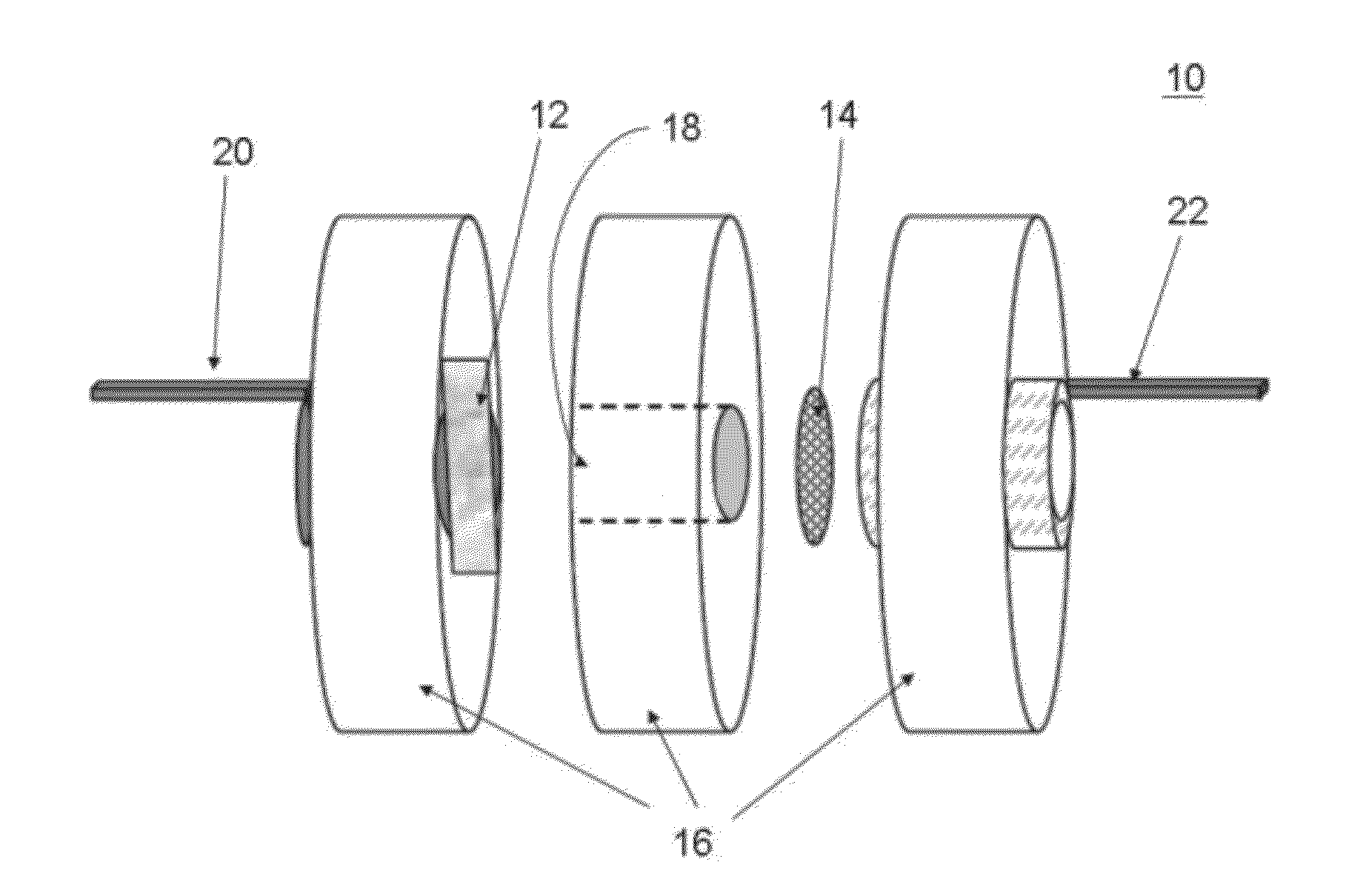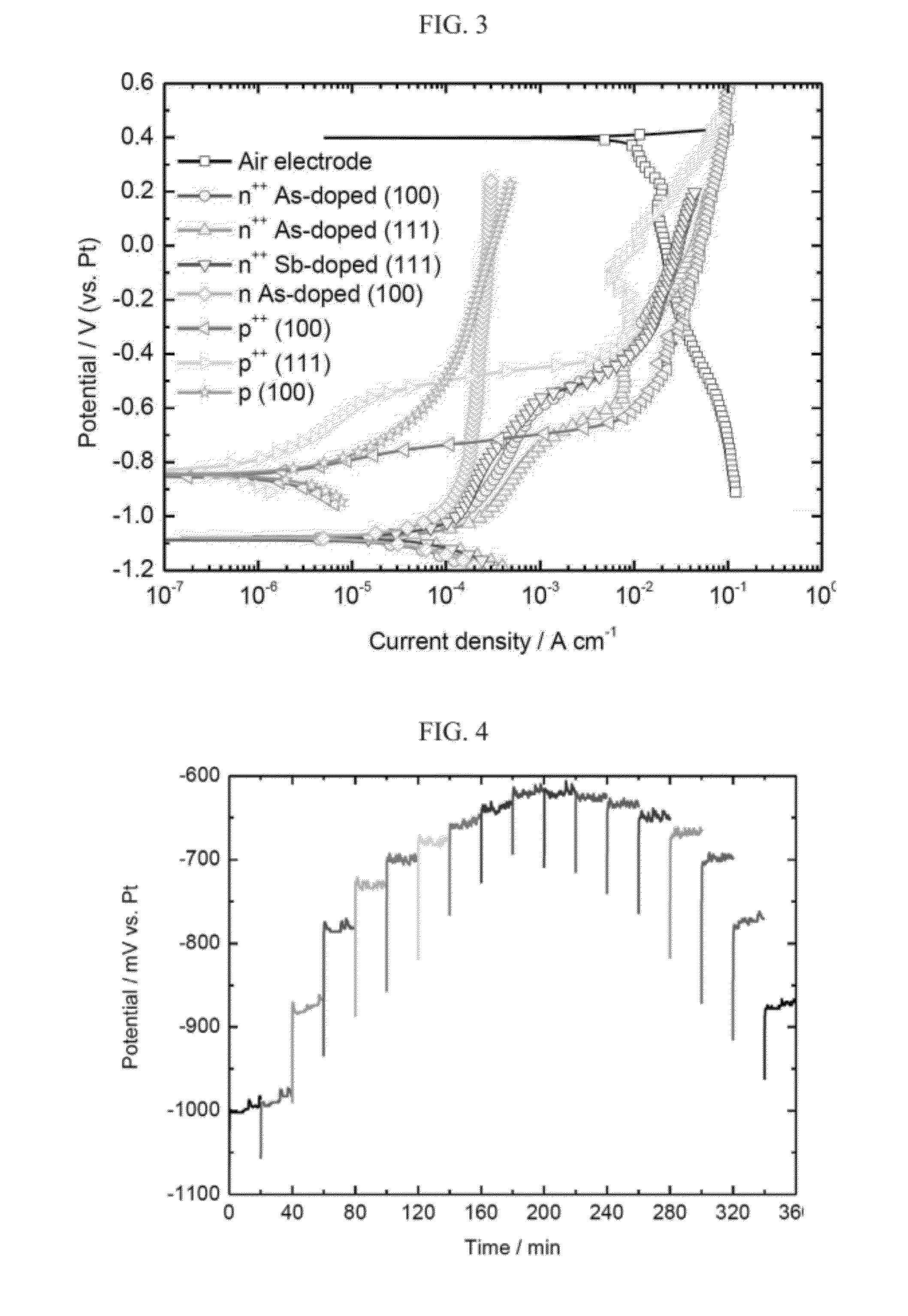Silicon-air batteries
- Summary
- Abstract
- Description
- Claims
- Application Information
AI Technical Summary
Benefits of technology
Problems solved by technology
Method used
Image
Examples
example 1
Half-Cell Analysis of Silicon-Air Battery
[0178]The sensitivity of silicon to KOH is a well known fact which is employed in the silicon industry to etch silicon. Silicon etching rate is measured to be in the order of tens of nm per minute and therefore, high rates of self discharge processes are expected from silicon-air batteries using KOH as the electrolyte. However, silicon-air batteries using the intuitive electrolyte KOH showed rapidly decreasing output due to extreme fast corrosion process of silicon in alkaline solutions.
[0179]To overcome the problems associated with aqueous alkaline electrolytes, non-aqueous room temperature ionic liquids RTIL were used as electrolytes in the following examples. Specifically, EMI.(HF)2.3F, an exemplary RTIL, was chosen as an alternative electrolyte due to its special features and due to the anodic features.
[0180]RTILs based on 1-Ethyl-3-methyl-imidazolium (EMI) cation exhibit low viscosity and high conductivity. The synthesis of EMI.(HF)2.3F ...
example 2
Galvanostatic Discharge Behavior
[0192]The galvanostatic discharge behavior of a silicon-air battery was studied by polarization of the working electrode against a Pt counter electrode at different current densities, resulting in up and down staircase curves, as presented in FIG. 4.
[0193]FIG. 4 presents the galvanostatic polarization curve as measured for an exemplary silicon-air battery according to the present invention, using a silicon [100] of anode heavily As-doped n-type (n++) and EMI.(HF)2.3F electrolyte (corresponding to the red curve having the circle symbol in FIG. 3), and current density from 100 μA per cm−2 to 1000 μA per cm−2 and back to 100 μA per cm−2, in 100 μA per cm−2 intervals, each for 20 minutes.
[0194]As can be seen in FIG. 4, the obtained half-cell potential value is more positive as the current density increases. However, frequent fluctuations are observed in each step of the 20 minutes constant current polarization. The frequency of these fluctuations depends ...
example 3
Silicon-Air Battery Discharge Performance
[0199]Silicon-air battery discharge performances under several current densities in ambient temperature were carried out in a cell configuration following the exemplary battery presented in FIG. 1. Data were collected using n++ As-doped silicon anode (see also the red curve, denoted with circle symbols in FIG. 3). Prior to any discharge, the cell was held at OCP for 4 hours, allowing the electrolyte to properly wet the porous carbon constitutes the air electrode. Discharge was terminated in a cut off voltage of 0.5 V.
[0200]FIG. 6 presents comparative discharge plots of an exemplary silicon-air batteries according to some embodiments of the present invention, using EMI.(HF)2.3F RTIL electrolyte at different constant current densities.
[0201]As can be seen in FIG. 6, the capacity values obtained for the silicon-air battery discharges are 3, 12.5, 15.25 and 26.7 mA per hour at current densities of 10, 50, 100 and 300 μA per cm2, respectively. As ...
PUM
 Login to View More
Login to View More Abstract
Description
Claims
Application Information
 Login to View More
Login to View More - R&D
- Intellectual Property
- Life Sciences
- Materials
- Tech Scout
- Unparalleled Data Quality
- Higher Quality Content
- 60% Fewer Hallucinations
Browse by: Latest US Patents, China's latest patents, Technical Efficacy Thesaurus, Application Domain, Technology Topic, Popular Technical Reports.
© 2025 PatSnap. All rights reserved.Legal|Privacy policy|Modern Slavery Act Transparency Statement|Sitemap|About US| Contact US: help@patsnap.com



